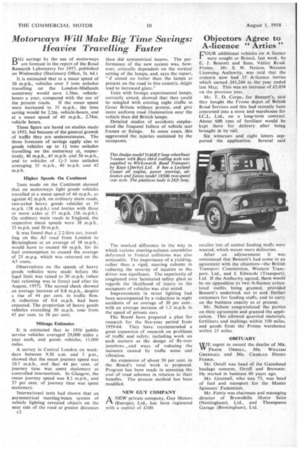Motorways Will Make Big Time Savings: Heavies Travelling Faster
Page 38

If you've noticed an error in this article please click here to report it so we can fix it.
BIG savings by the use of motorways are forecast in the report of the Road Research Laboratory for 1957. published on Wednesday (Stationery Office, 5s. 6d.).
It is estimated that at a mean' speed of 30 M.p.h., vehicles over 3 tons unladen travelling on the London-Midlands motorway would save 1.56m. vehiclehours 4 year, compared with the use of the present roads. If the mean speed were increased to 35 m.p.h., the time saving would be 2.2m, vehicle-hours, and at a mean speed of 40 m.p.h., 2.74m. vehicle hours.
These figure are based on studies made in 1955, but because of the general growth of traffic they are underestimates. The three forecasts of savings .apply also to goods vehicles up to 11 tons unladen travelling on the motorway at, respectively, 40 m.p.h., 45 m.p.h. and 50 m.p.h., and to vehicles of 11-3 tons unladen averaging 35 m.p.h., 40 'm.p.h. and 45 m.p.h.
Higher Speeds On Continent Tests made on the Continent showed that on motorways light goods vehicles travelled at a mean speed of 44 m.p.h., as against 42 m.p.h. on ordinary main roads. two-axled heavy goods vehicles at 39 m.p.h. (38 m.p.h.) and lorries with three or more axles at 37 m.p.h. (36 m.p.h.). On ordinary main roads in England, the respective mean speeds were 38 m.p.h.. 33 m.p.h. and 30 m.p.h.
It was found that a 2.2-litre car, travelling on the AS road from London to Birmingham at an average of 38 m.p.h., would have to exceed 60 m.p.h. for its fuel consumption to .exceed the average of 25 m.p.g. which was returned on the AS route.
Observations on the speeds of heavy goods vehicles were made before the legal limit was raised to 30 m.p.h. (when fuel rationing was in force) and after (in August, 1957). The second check showed an average increase of 0.8 m.p.h., despite a rise of 44 per cent, in traffic flow. sk• reduction of 0.4 m.p.h. had been expected. The proportion of heavy goods vehicles exceeding 30 m.p.h. rose from 45 per cent. to 56 per cent.
Mileage Estimates
It is estimated that in 1956 public service vehicles averaged 29,000 miles a year each, and goods vehicles, 11,000 miles.
A survey in Central London on weekdays between 9.30 a.m. and 5 p.m., showed that the mean journey speed was 10.7 .m.p.h., and . that 44 per cent, of journey time was spent stationary at controlled intersections, In Glasgow, the mean journey speed was 8.2 m.p.h., and '37 per cent, of journey time was spent stationary.
International tests had shown that an asymmetrical meeting-beam system n of vehicle lighting revealed objects on the near side of the road at greater distances c2 than did symmetrical beams. The performance of the new system was, however, critically dependent on the vertical setting of the tamps, and, says the report, "if aimed no better than the lamps at present on the road in this country, might lead to increased glare."
Tests with foreign experimental lamps, correctly aimed, showed that they could be mingled with existing night traffic in Great Britain without protest, and give more uniform road illumination near the vehicle than did British lamps.
Detailed studies of accidents emphasized the frequent failure of vehicle seat frames or fixings. In some cases, this aggravated the injuries sustained by the occupants.
The marked difference in the way in which various steering-column assemblies deformed in frontal collisions was also noticeable. The importance of a yielding, rather than a rigid, steering column in reducing the severity of injuries to the driver was significant. The superiority of toughened over laminated safety glass as regards the likelihood of injury to the occupants of vehicles was also noted.
Improvements in street lighting had been accompanied by a reduction in night accidents of an average of 30 per cent.; with an average increase of 1.2 m.p.h. in
the speed of private cars. .
The Board have prepared a plan for research for the five-year period from 1959-64. They, have recommended a great expansion of research on problems of traffic and safety, including work on such matters as the design of fly-over junctions • and ways of reducing the nuisance caused by traffic noise and vibration.
An expansion of about 50 per cent. in the Board's total work is proposed. Progress has been made in assessing the cost of road schemes in relation to their benefits. The present method has been modified.
NEW GUY COMPANY A NEW private company, Guy Motors L-16 (Europe), Ltd., has been registered with a capital of £100.
































































































